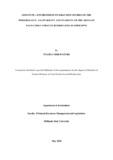Please use this identifier to cite or link to this item:
https://cris.library.msu.ac.zw//handle/11408/3274| Title: | Genotype × environment interaction studies on the performance, adaptability and stability of pre- release flue-cured tobacco hybrid lines in Zimbabwe | Authors: | Chikwature, Nyasha | Keywords: | Genotype × environment interaction Tobacco Yield Quality Stability Adaptability |
Issue Date: | 2018 | Publisher: | Midlands State University | Abstract: | The nature and magnitude of the genotype × environment interactions is important to identify superior and stable genotypes under target environments. This will assist to maximize specific adaptation and to speed up the distribution of new cultivars to growers. Eleven pre-release flue cured tobacco hybrid lines were evaluated for yield and quality in four different tobacco growing regions thus, Kutsaga and Rusape representing the slow growing areas, Trelawney representing the medium growing areas and Tengwe representing the fast growing areas . The thrust of this study was to assess the stability and adaptability of these hybrid lines. KRK 26R was used as a positive check line because it is a cultivar that is adaptable and stable to a wide range of environments. The hybrid lines were raised with the new float tray system of seedling production and all cultural practises were done following the TRB handbook recommendations. Significant genotype × environment variations were observed among the hybrid lines. For the total saleable yield, environmental high significant difference was observed (P = 0.001), the study revealed that Tengwe had the best yield of 2755kg/ha, while, Kutsaga had the least yield of 1934kg/ha. For the grade index genotypic highly significant difference was observed (P = 0.001) with G9 outperforming all other test genotypes including the check line with an index of 61.74, while, G1 least performed with an index of 51.0. For the top grades proportion Genotype × Environment interaction was found and GGE biplot procedure was followed and results indentified the stability and adaptability of the performance of the hybrid lines. The GGE biplots indentified that G7, G8 and G11 as the high quality and stable genotypes. G1, G2 and G5 least performed and had low stability. It was observed that Kutsaga that is located in the slow growing areas as the ideal testing environment for these set of hybrids that were under test. | URI: | http://hdl.handle.net/11408/3274 |
| Appears in Collections: | Bsc Crop Production And Horticulture Honours Degree |
Files in This Item:
| File | Description | Size | Format | |
|---|---|---|---|---|
| CHIKWATURE NYASHA.pdf | Full Text | 997.78 kB | Adobe PDF |  View/Open |
Page view(s)
110
checked on Feb 26, 2025
Download(s)
82
checked on Feb 26, 2025
Google ScholarTM
Check
Items in MSUIR are protected by copyright, with all rights reserved, unless otherwise indicated.


